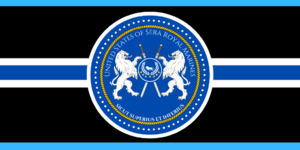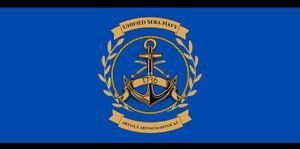Seran Armed Forces
| Military of Unified Sera | |
|---|---|
| Seran Armed Forces | |
 | |
 | |
| Founded | 7 June 1741 |
| Service branches | 4 |
| Headquarters | 1700 North King's Way, Providence, Kado, The United States of Sera |
| Website | ussaf.us.mil |
| Leadership | |
| Supreme Commander | |
| Director of National Security | |
| Chairman of the BoDM | |
| Personnel | |
| Military age | 18-39 |
| Conscription | Yes |
| Fit for military service | 10,230,510 males, age 18-39, 10,563,210 females, age 18-39 |
| Active personnel | 506,838 |
| Reserve personnel | 20,793,721 |
| Expenditure | |
| Budget | |
| Percent of GDP | 20.3% |
| Industry | |
| Domestic suppliers | Ironforge International, The Enterprise Group, The Cetanu-Yutani Corporation |
The United States of Sera Military, Seran Armed Forces (SAF), and colloquially known as the Royal Armed Forces (RAF) is the designated military forces for the United States of Sera. The armed forces contains five active service branches: the Royal Army, Royal Marines, Royal Navy, Royal Air Force, and the Valkiri Royal Guard. Although Sera has a coast guard, the coast guard is organized and run by the Department of National Security instead of the Department of War. The Prime Minister of the USS acts as the High Commander for the Seran Armed Forces and dictates military policy, tactics, regulations, and protocols with the Chairman of the Board of Defense Ministers, Secretary of War, and Director of National Security. During rare occurrences, the Monarch of Sera is granted the ability to lead the armed forces in the Prime Minister's stead. However, such an occasion can only be granted by Parliament in the event that the acting Prime Minister is found incompetent or otherwise incapable of fulfilling their duties.
After being formed on June 7th, 1741 on Unification Day, the SAF have played a pivotal role in Seran and world history. The shared identity and mission of the branches provided much needed unity to the newly formed nation and offered structure and discipline to the newly created warrior caste. The branches served the nation for over 200 years by defending the people from secessionists during the early 1800s during the Secessionist War, protected the borders during the anti-piracy operations of the early 2000s, and defeated the rouge nation Sparta Eternal during the Invasion of Sparta in the middle of 2021.
The SAF boasts some of the most well-trained military forces in the world due to the devoted Warrior Caste that makes up the majority of active duty personnel. These soldiers spend their free time training, honing their skills, and perfecting their form and disciple at all hours of the day when not actively engaged in operations. Although not as technically advanced as other nations or as large, the SAF also relies on a national conscription program that can mobilize a vast number of individuals regardless of caste. Moreover, the conscription program of all adults turning 18 into the SAF ensures that every civilian (barring those with disability) receives military training and are required by law to be recertified with weapon handling every five years to maintain proficiency.
History
Structure
Service Branches
Seran Royal Army
| Seran Royal Army | |
|---|---|
 | |
| Type | Army |
| Role | Prompt and sustained land combat Combined arms operations
Set and sustain the theater for the joint force Integrate national, multinational, and joint power on land |
| Size | 485,000 Regular Army personnel (2021) |
| Motto(s) | "Semper Paratus" |
| Colors | Black, gold and red |
The United States of Sera Royal Army, also called the Royal Army, US Army, and Union Army is a branch of the Seran military beneath the Department of War and Board of Defense Ministers. The Royal Army is headed by the Chief of the Army, a member of the Board of Defense Ministers (the highest ranking army officer) and the Secretary of the Royal Army. The Royal Army was officially established on June 7th, 1741 by the Quadrumvirate in the present day capital of Kito'Bahari in response to growing external threats to the Union of Seran Tribes. Before the establishment of a national army, each state in the Seran Union provided their own troops and commanders for national defense. These commanders were prone to disagreements with each other, while soldiers from different tribes would routinely fight amongst themselves due to cultural differences. The Quadrumvirate sought to nullify the worst offenders by removing them from their position and sending them to prison to avoid possible coups against the Quadrumvirate. Soon thereafter, new commanders were appointed from within the tribes to take their place with a particular focus on unification and standardization over individualization and cultural differences.
Originally, the US Army handled both peacekeeping tasks domestically within the first tribal states while also juggling the demands of protecting the borders around the fledgling country from the neighboring violent tribes of ancient Adula. The Quadrumvirate, fearing nepotism, instituted a system amongst Sera's warriors that rewarded soldiers with prestige, wealth, and position for accomplishing certain tasks. These tasks included bringing the heads of enemy war-leaders, scalps, securing weaponry, repelling attacks, and spear-heading successful raids against enemy territories. Due to the ferocity at which Seran warriors pursued enemy heads and scalps, a reputation began to grow amongst their neighbors surrounding Seran brutality in war.
This reputation continued to grow as the Union of Sera entered into a war with the neighboring Nafuni Ze'teca Tribe known as the Seran-Ze'teca Extermination War. The conflict broke out when the Nafuni Ze'teca tribe crossed the Adula Mountains and entered into the Mbaku controlled tribe-lands. The Ze'teca immediately began to pillage and destroy any villages they came across and murdered any Seran inhabitants they captured. The newly formed national army was dispatched to combat the Ze'tecas. The Seran Army clashed several times over the next four years with the Ze'tecas; each time the officers in charge of the Seran soldiers ordered that no mercy be shown. Eventually, this harsh treatment of the Ze'teca would lead to the near total annihilation of the Nafuni Ze'teca nation as the Seran Army chased them across the mountains into their homeland. Although victorious, the Quadrumvirate quickly did away with the practice of rewarding soldiers for heads and scalps, partially due to the shame of nearly committing genocide.



